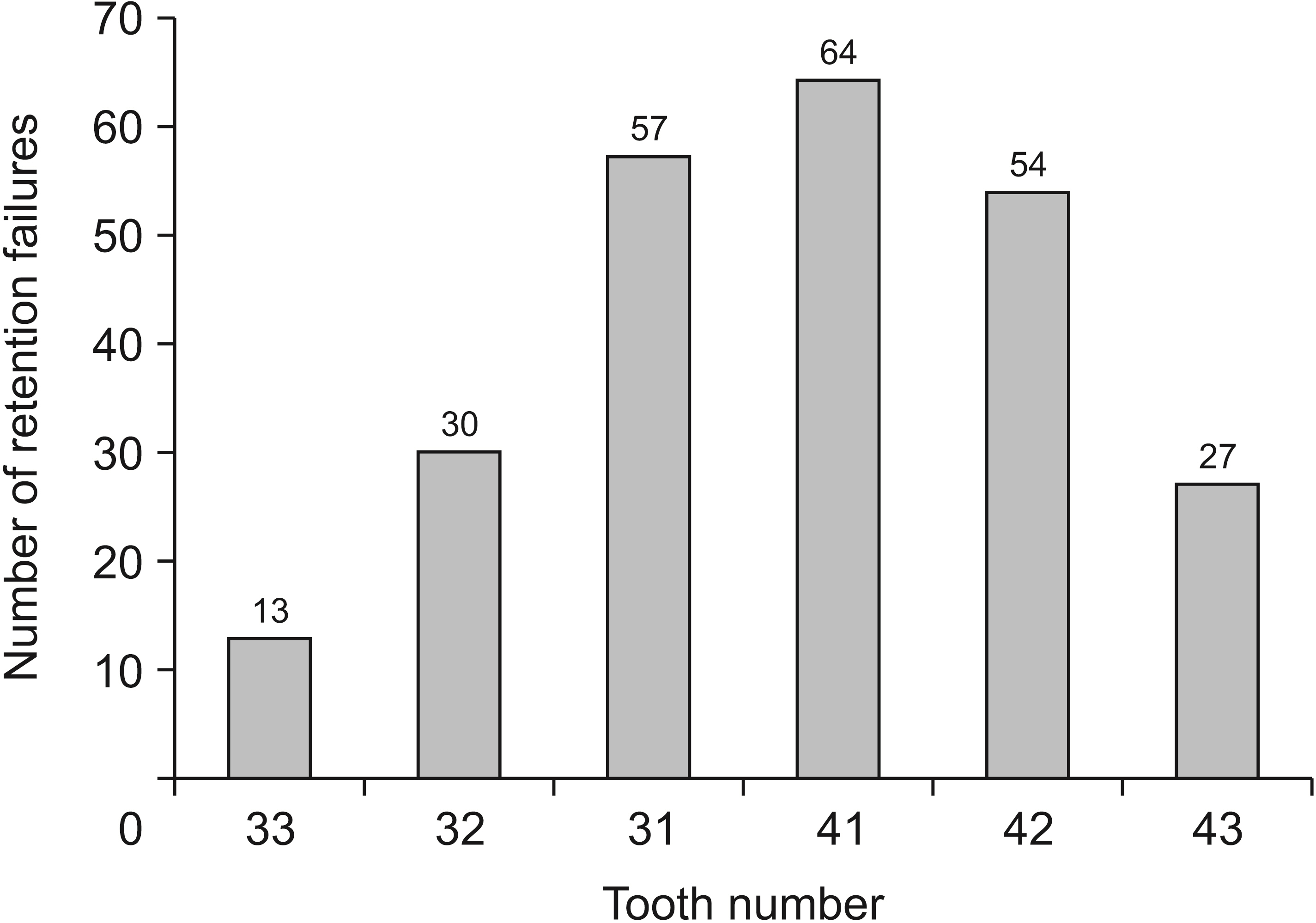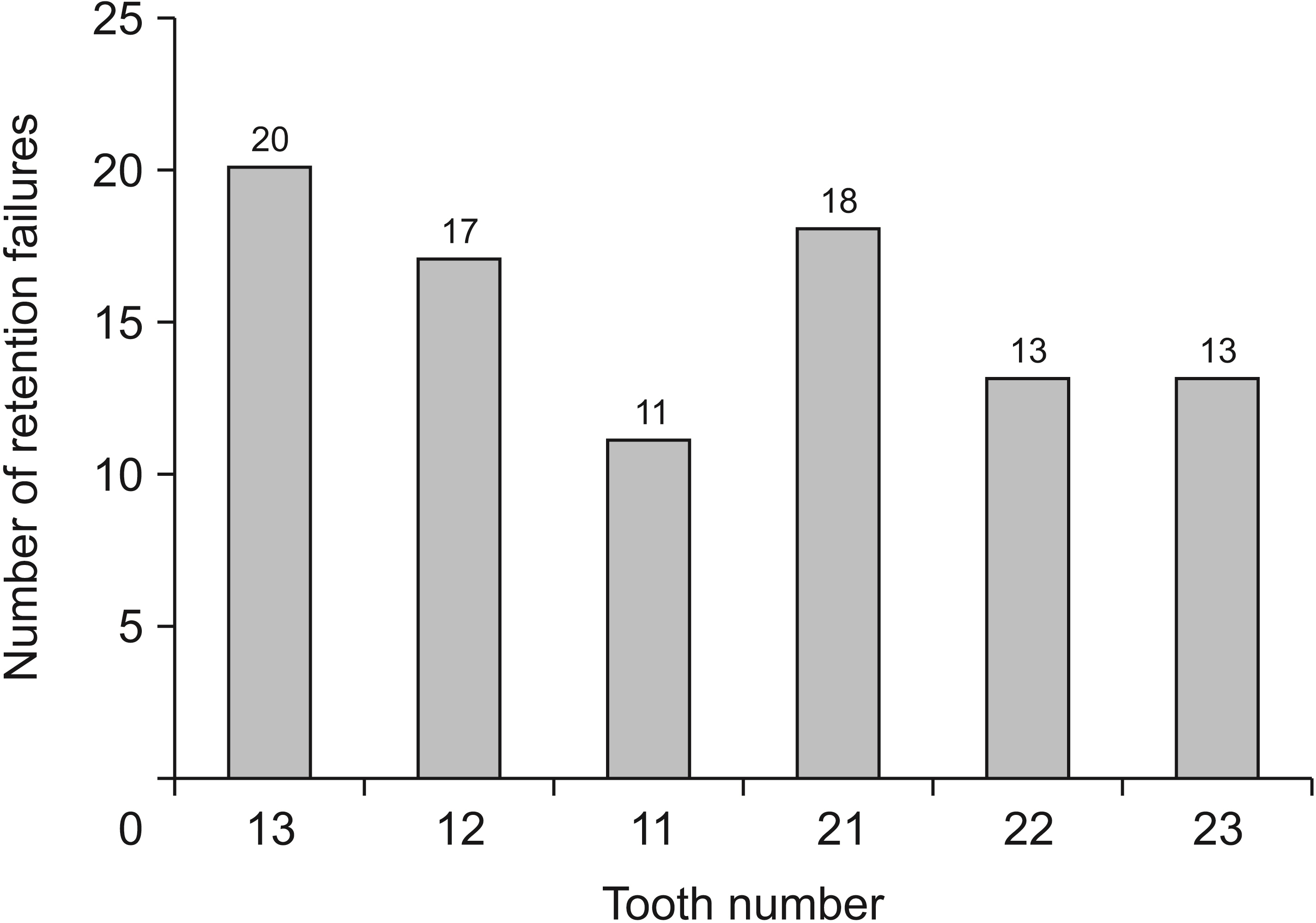Korean J Orthod.
2023 Nov;53(6):365-373. 10.4041/kjod23.012.
Risk factors for orthodontic fixed retention failure: A retrospective controlled study
- Affiliations
-
- 1Department of Oral Health SciencesOrthodontics, KU Leuven and Dentistry, University Hospitals Leuven, Leuven, Belgium
- KMID: 2548481
- DOI: http://doi.org/10.4041/kjod23.012
Abstract
Objective
To investigate the potential correlation between fixed orthodontic retention failure and several patient- and treatment-related factors.
Methods
Patients finishing treatment with fixed appliances between 2016 and 2017 were retrospectively included in this study. Those not showing fixed retention failure were considered as control group. Patients with fixed retention failure were considered as the experimental group. Additionally, patients with failure of fixed retainers in the period of June 2019 to March 2021 were prospectively identified and included in the experimental group. The location of the first retention failure, sex, pretreatment dental occlusion, facial characteristics, posttreatment dental occlusion, treatment approach and presence of oral habits were compared between groups before and after treatment separately by using a Fisher exact test and a Mann–Whitney U test.
Results
206 patients with fixed retention failure were included, 169 in the mandibular and 74 in the maxillary jaws. Significant correlations were observed between retention failure in the mandibular jaws and mandibular arch length discrepancy (P = 0.010), post-treatment growth pattern (P = 0.041), nail biting (P < 0.001) and abnormal tongue function (P = 0.002). Retention failure in the maxillary jaws was more frequent in patients with IPR in the mandibular jaws (P = 0.005) and abnormal tongue function (P = 0.021).
Conclusions
This study suggests a correlation between fixed retention failure and parafunctional habits, such as nail biting and abnormal tongue function. Prospective studies with larger study populations could further confirm these results.
Keyword
Figure
Reference
-
1. Iliadi A, Kloukos D, Gkantidis N, Katsaros C, Pandis N. 2015; Failure of fixed orthodontic retainers: a systematic review. J Dent. 43:876–96. https://doi.org/10.1016/j.jdent.2015.05.002. DOI: 10.1016/j.jdent.2015.05.002. PMID: 25979824.
Article2. Zachrisson BU. 2015; Multistranded wire bonded retainers: from start to success. Am J Orthod Dentofacial Orthop. 148:724–7. https://doi.org/10.1016/j.ajodo.2015.07.015. DOI: 10.1016/j.ajodo.2015.07.015. PMID: 26522030.
Article3. Segner D, Heinrici B. 2000; Bonded retainers--clinical reliability. J Orofac Orthop. 61:352–8. https://doi.org/10.1007/pl00001905. DOI: 10.1007/PL00001905. PMID: 11037687.
Article4. Jedliński M, Grocholewicz K, Mazur M, Janiszewska-Olszowska J. 2021; What causes failure of fixed orthodontic retention? - systematic review and meta-analysis of clinical studies. Head Face Med. 17:32. https://doi.org/10.1186/s13005-021-00281-3. DOI: 10.1186/s13005-021-00281-3. PMID: 34301280. PMCID: PMC8306281. PMID: 58f604c465284a039a7f7de8d67089ba.
Article5. Taner T, Aksu M. 2012; A prospective clinical evaluation of mandibular lingual retainer survival. Eur J Orthod. 34:470–4. https://doi.org/10.1093/ejo/cjr038. DOI: 10.1093/ejo/cjr038. PMID: 21508264.6. Kučera J, Littlewood SJ, Marek I. 2021; Fixed retention: pitfalls and complications. Br Dent J. 230:703–8. https://doi.org/10.1038/s41415-021-2892-4. DOI: 10.1038/s41415-021-2892-4. PMID: 34117424.
Article7. Dahl EH, Zachrisson BU. 1991; Long-term experience with direct-bonded lingual retainers. J Clin Orthod. 25:619–30. https://pubmed.ncbi.nlm.nih.gov/1814943/. PMID: 1814943.8. Zachrisson BU. 2007; Long-term experience with direct-bonded retainers: update and clinical advice. J Clin Orthod. 41:728–37. quiz 749https://pubmed.ncbi.nlm.nih.gov/18192755/. PMID: 18192755.9. Gerami A, Dadgar S, Rakhshan V, Jannati P, Sobouti F. 2016; Displacement and force distribution of splinted and tilted mandibular anterior teeth under occlusal loads: an in silico 3D finite element analysis. Prog Orthod. 17:16. https://doi.org/10.1186/s40510-016-0129-x. DOI: 10.1186/s40510-016-0129-x. PMID: 27245235. PMCID: PMC4887454. PMID: b200a18c732f475c8bab920faf488bfd.
Article10. Edman Tynelius G, Petrén S, Bondemark L, Lilja-Karlander E. 2015; Five-year postretention outcomes of three retention methods--a randomized controlled trial. Eur J Orthod. 37:345–53. https://doi.org/10.1093/ejo/cju063. DOI: 10.1093/ejo/cju063. PMID: 25452629.
Article11. Littlewood SJ, Kandasamy S, Huang G. 2017; Retention and relapse in clinical practice. Aust Dent J. 62 Suppl 1:51–7. https://doi.org/10.1111/adj.12475. DOI: 10.1111/adj.12475. PMID: 28297088.
Article12. Lie Sam Foek DJ, Ozcan M, Verkerke GJ, Sandham A, Dijkstra PU. 2008; Survival of flexible, braided, bonded stainless steel lingual retainers: a historic cohort study. Eur J Orthod. 30:199–204. https://doi.org/10.1093/ejo/cjm117. DOI: 10.1093/ejo/cjm117. PMID: 18222927.
Article13. Konermann A, Al-Malat R, Skupin J, Keilig L, Dirk C, Karanis R, et al. 2017; In vivo determination of tooth mobility after fixed orthodontic appliance therapy with a novel intraoral measurement device. Clin Oral Investig. 21:1283–9. https://doi.org/10.1007/s00784-016-1881-5. DOI: 10.1007/s00784-016-1881-5. PMID: 27324475.
Article14. Lindhe J, Ericsson I. 1982; The effect of elimination of jiggling forces on periodontally exposed teeth in the dog. J Periodontol. 53:562–7. https://doi.org/10.1902/jop.1982.53.9.562. DOI: 10.1902/jop.1982.53.9.562. PMID: 6957593.
Article15. O'Leary TJ, Rudd KD, Nabers CL, Stumpf AJ Jr. 1967; The effect of a "tube-type" diet and stress-inducing conditions on tooth mobility. J Periodontol. 38:222–6. https://doi.org/10.1902/jop.1967.38.3.222. DOI: 10.1902/jop.1967.38.3.222. PMID: 4960948.16. Posen AL. 1972; The influence of maximum perioral and tongue force on the incisor teeth. Angle Orthod. 42:285–309. https://pubmed.ncbi.nlm.nih.gov/4507148/. DOI: 10.1043/0003-3219(1972)042<0285:TIOMPA>2.0.CO;2. PMID: 4507148.17. Klein ET. 1952; Pressure habits, etiological factors in malocclusion. Am J Orthod. 38:569–87. https://doi.org/10.1016/0002-9416(52)90025-0. DOI: 10.1016/0002-9416(52)90025-0.
Article18. Steiner CC. 1953; Cephalometrics for you and me. Am J Orthod. 39:729–55. https://doi.org/10.1016/0002-9416(53)90082-7. DOI: 10.1016/0002-9416(53)90082-7.
Article19. Özcan M, Koc-Dundar B. 2014; Composite-composite adhesion in dentistry: a systematic review and meta-analysis. J Adhes Sci Technol. 28:2209–29. https://doi.org/10.1080/01694243.2014.954659. DOI: 10.1080/01694243.2014.954659.
Article20. Oliveira AC, Paiva SM, Campos MR, Czeresnia D. 2008; Factors associated with malocclusions in children and adolescents with Down syndrome. Am J Orthod Dentofacial Orthop. 133:489.e1–8. https://doi.org/10.1016/j.ajodo.2007.09.014. DOI: 10.1016/j.ajodo.2007.09.014. PMID: 18405808.
Article21. Fleming PS, Johal A, Pandis N. 2012; Self-etch primers and conventional acid-etch technique for orthodontic bonding: a systematic review and meta-analysis. Am J Orthod Dentofacial Orthop. 142:83–94. https://doi.org/10.1016/j.ajodo.2012.02.023. DOI: 10.1016/j.ajodo.2012.02.023. PMID: 22748994.
Article22. Kartal Y, Kaya B. 2019; Fixed orthodontic retainers: a review. Turk J Orthod. 32:110–4. https://doi.org/10.5152/turkjorthod.2019.18080. DOI: 10.5152/TurkJOrthod.2019.18080. PMID: 31294414. PMCID: PMC6605884. PMID: 14f33617318f426f87171fa36e52a949.
Article23. Schneider E, Ruf S. 2011; Upper bonded retainers. Angle Orthod. 81:1050–6. https://doi.org/10.2319/022211-132.1. DOI: 10.2319/022211-132.1. PMID: 21657830. PMCID: PMC8903852.
Article24. Johnsson AC, Tofelt LN, Kjellberg H. 2007; Subjective evaluation of orthodontic treatment and potential side effects of bonded lingual retainers. Swed Dent J. 31:35–44. https://pubmed.ncbi.nlm.nih.gov/17508708/. PMID: 17508708.25. Jin C, Bennani F, Gray A, Farella M, Mei L. 2018; Survival analysis of orthodontic retainers. Eur J Orthod. 40:531–6. https://doi.org/10.1093/ejo/cjx100. DOI: 10.1093/ejo/cjx100. PMID: 29370399.
Article
- Full Text Links
- Actions
-
Cited
- CITED
-
- Close
- Share
- Similar articles
-
- Clinical study on the relapse of diastema
- Non-surgical treatment and retention of open bite in adult patients with orthodontic mini-implants
- Effect of malocclusion or orthodontic treatment on oral health-related quality of life in adults
- Considerations for Orthodontic Treatment in Elderly Patients
- Frictional forces in the fixed orthodontic appliance during tooth movement



